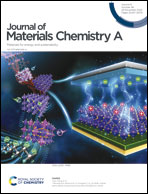A new high-Li+-conductivity Mg-doped Li1.5Al0.5Ge1.5(PO4)3 solid electrolyte with enhanced electrochemical performance for solid-state lithium metal batteries†
Abstract
Li1.5Al0.5Ge1.5(PO4)3 (LAGP) is a promising solid electrolyte for use in next-generation lithium batteries. Nevertheless, its lower bulk and grain-boundary ionic conductivities are major restrictions preventing its practical utilization. Mg was introduced into LAGP to form Li1.6Al0.4Mg0.1Ge1.5(PO4)3 (LAMGP) based on computational analysis. The doping of LAGP with Mg results in advantages such as increasing the Li+ concentration and expanding the material dimensions due to the larger ionic radius of Mg, leading to enhanced ionic conductivity. Mg had a two-birds-with-one-stone effect in the LAMGP electrolyte, not only generating super high bulk ionic conductivity of 7.435 mS cm−1, compared to 2.896 mS cm−1 in LAGP, but also generating low grain-boundary resistance due to improved densification. The lowering of the grain-boundary resistance and the increased densification are related to choosing the right precursor for the dopant. Using LAMGP as a hybrid solid electrolyte, a solid battery delivered great electrochemical performance in comparison to when LAGP was used. Interfacial analysis was also conducted, which revealed that the formation of an interface prevented the reduction of components in LAMGP by Li metal, therefore ensuring the long-term durability of LAMGP in liquid electrolyte. These results suggest that LAMGP is an auspicious solid electrolyte for achieving practical solid-state lithium batteries.



 Please wait while we load your content...
Please wait while we load your content...